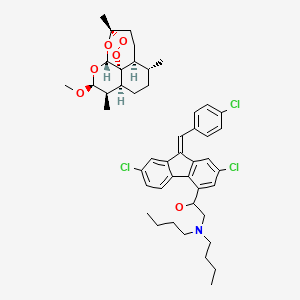Attribution Statement: LactMed is a registered trademark of the U.S. Department of Health and Human Services.
NCBI Bookshelf. A service of the National Library of Medicine, National Institutes of Health.
Drugs and Lactation Database (LactMed®) [Internet]. Bethesda (MD): National Institute of Child Health and Human Development; 2006-.
CASRN: 141204-94-6

Drug Levels and Effects
Summary of Use during Lactation
Artemether and lumefantrine have not been studied in nursing mothers. Estimates of its excretion into breastmilk indicate that amounts in milk are very low. The Centers for Disease Control and Prevention consider the drug combination acceptable for use in mothers nursing an infant weighing at least 5 kg (11 pounds) and it can be given directly to infants weighing 5 kg or more.[1] The safety of the combination in breastfed infants under 5 kg is not known. Tablets can be crushed and administered in breastmilk to enhance absorption in small infants.[2]
Drug Levels
Maternal Levels. The excretion of artemether and lumefantrine in breastmilk was estimated from average maximum serum concentrations after a standard 6-dose regimen of artemether 40 mg and lumefantrine 240 mg daily, assuming a M/P ratio of 1.04 for artemether and 1.3 for lumefantrine. The authors estimated that a fully breastfed infant would receive 0.03 mg daily of artemether or less than 0.4% of the recommended dose for a 5 kg infant, and 5 mg daily of lumefantrine or less than 10% of the recommended dose for a 5 kg infant.[3]
Infant Levels. Relevant published information was not found as of the revision date.
Effects in Breastfed Infants
Relevant published information was not found as of the revision date.
Effects on Lactation and Breastmilk
Relevant published information was not found as of the revision date.
Alternate Drugs to Consider
References
- 1.
- Centers for Disease Control and Prevention. CDC Yellow Book 2020: Health Information for International Travel. New York: Oxford University Press 2019. https://wwwnc
.cdc.gov /travel/yellowbook/2020 /travel-related-infectious-diseases /malaria. - 2.
- Adjei GO, Goka BQ, Binka F, et al. Artemether-lumefantrine: an oral antimalarial for uncomplicated malaria in children. Expert Rev Anti Infect Ther. 2009;7:669–81. [PubMed: 19681693]
- 3.
- Jain JP, Ganesan S, Lefevre G, et al. Estimating of the amount of artemether and lumefantrine excreted through breast milk. Trop Med Int Health 2015;20 (Suppl. S1):184-5. Abstract. doi: 10.1111/tmi.12574. [CrossRef]
Substance Identification
Substance Name
Artemether and Lumefantrine
CAS Registry Number
141204-94-6
Drug Class
Breast Feeding
Anti-Infective Agents
Antiparasitic Agents
Antimalarials
Antiprotozoal Agents
Disclaimer: Information presented in this database is not meant as a substitute for professional judgment. You should consult your healthcare provider for breastfeeding advice related to your particular situation. The U.S. government does not warrant or assume any liability or responsibility for the accuracy or completeness of the information on this Site.
- User and Medical Advice Disclaimer
- Drugs and Lactation Database (LactMed) - Record Format
- LactMed - Database Creation and Peer Review Process
- Fact Sheet. Drugs and Lactation Database (LactMed)
- Drugs and Lactation Database (LactMed) - Glossary
- LactMed Selected References
- Drugs and Lactation Database (LactMed) - About Dietary Supplements
- Breastfeeding Links
- PubChem SubstanceRelated PubChem Substances
- PubMedLinks to PubMed
- Review Artesunate.[Drugs and Lactation Database (...]Review Artesunate.. Drugs and Lactation Database (LactMed®). 2006
- A randomized, open-label, comparative efficacy trial of artemether-lumefantrine suspension versus artemether-lumefantrine tablets for treatment of uncomplicated Plasmodium falciparum malaria in children in western Kenya.[Malar J. 2008]A randomized, open-label, comparative efficacy trial of artemether-lumefantrine suspension versus artemether-lumefantrine tablets for treatment of uncomplicated Plasmodium falciparum malaria in children in western Kenya.Juma EA, Obonyo CO, Akhwale WS, Ogutu BR. Malar J. 2008 Dec 22; 7:262. Epub 2008 Dec 22.
- Review Understanding the pharmacokinetics of Coartem.[Malar J. 2009]Review Understanding the pharmacokinetics of Coartem.Djimdé A, Lefèvre G. Malar J. 2009 Oct 12; 8 Suppl 1(Suppl 1):S4. Epub 2009 Oct 12.
- Evaluation of two novel tablet formulations of artemether-lumefantrine (Coartem) for bioequivalence in a randomized, open-label, two-period study.[Malar J. 2013]Evaluation of two novel tablet formulations of artemether-lumefantrine (Coartem) for bioequivalence in a randomized, open-label, two-period study.Lefèvre G, Bhad P, Jain JP, Kalluri S, Cheng Y, Dave H, Stein DS. Malar J. 2013 Sep 8; 12:312. Epub 2013 Sep 8.
- Early clinical development of artemether-lumefantrine dispersible tablet: palatability of three flavours and bioavailability in healthy subjects.[Malar J. 2010]Early clinical development of artemether-lumefantrine dispersible tablet: palatability of three flavours and bioavailability in healthy subjects.Abdulla S, Amuri B, Kabanywanyi AM, Ubben D, Reynolds C, Pascoe S, Fitoussi S, Yeh CM, Nuortti M, Séchaud R, et al. Malar J. 2010 Sep 3; 9:253. Epub 2010 Sep 3.
- Artemether and Lumefantrine - Drugs and Lactation Database (LactMed®)Artemether and Lumefantrine - Drugs and Lactation Database (LactMed®)
Your browsing activity is empty.
Activity recording is turned off.
See more...
